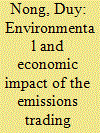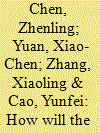|
|
|
Sort Order |
|
|
|
Items / Page
|
|
|
|
|
|
|
| Srl | Item |
| 1 |
ID:
150032


|
|
|
|
|
| Summary/Abstract |
To fulfill its Copenhagen pledges to control carbon emissions and mitigate climate change, China plans to establish a nationwide emissions trading scheme (ETS) in 2016. This paper develops a multi-sector dynamic computable general equilibrium model with an ETS module to study the appropriate ETS policy design, including a carbon cap, permit allocation and supplementary policies (e.g., penalty policies and subsidy policies). The main results are as follows. (1) To achieve China's Copenhagen pledge, the equilibrium nationwide carbon price is observed to be between 36 and 40 RMB yuan per metric ton. (2) The ETS policy has a cost-effective mitigation effect by improving China's production and energy structures with relatively little economic harm. (3) Various ETS sub-policies should be carefully designed to balance economic growth and carbon mitigation. In particular, the carbon cap should be set according to China's Copenhagen pledge. A relatively large distribution ratio of free permits, the output-based grandfathering rule for free permits, a penalty price (on illegitimate emissions) slightly above the carbon price, and a sufficient subsidy (from ETS revenue) are strongly recommended in the early stages to avoid significant economic loss. These designs can be adjusted in later stages to enhance the mitigation effect.
|
|
|
|
|
|
|
|
|
|
|
|
|
|
|
|
| 2 |
ID:
176764


|
|
|
|
|
| Summary/Abstract |
This study aims to fill a gap in the literature by examining the impacts of an emissions trading scheme (ETS) in Vietnam, as the policy has been discussed for a decade in the country but the likely impacts on the economy and different sectors are still unidentified. The simulations are carried out in a global energy computable general equilibrium (CGE) model, an extension of the GTAP-E model, which treats Vietnam as a country region. Results show that restricting the number of industrial sectors in the emissions trading market substantially affects the country's economy with a decline in real GDP by 4.57%. However, the country experiences much smaller adverse impacts (e.g., real GDP declines by 1.78%) when all industries participate in the emissions trading market. In either case of the ETS design, the coal mining, manufacturing, transportation, and electricity sectors are highly adversely affected; however, the crude oil and natural gas extraction sectors would experience expansion in their production levels due to substitutions for coal. In general, under the policy the emission levels from burning fossil fuels decline at significant rates, particularly from the electricity generation sector.
|
|
|
|
|
|
|
|
|
|
|
|
|
|
|
|
| 3 |
ID:
171409


|
|
|
|
|
| Summary/Abstract |
The implementation of a national emissions trading scheme (ETS) in China is likely to have an important effect on potential regional gains. This study proposes a unified analytical framework for anticipating such gains in 2020 and estimates the key factors involved using data envelopment analysis based models. The results indicate that: (1) when the value of the marginal abatement cost is higher than the carbon price, no regions will have an incentive to reduce emissions by technological improvements. The only source of direct potential gains is from the amounts of carbon quota. (2) As carbon price increases from CNY 10 to 4000 per ton, the indirect potential gains will increase because the strategies for carbon reduction are technological innovation or limit economic activities. However, Jiangsu and Shanghai will suffer potential losses even though the price is high because they have no more carbon reduction potential. (3) Most central provinces will have potential gains when the carbon price is lower in ETS, while regions rich in fossil energy sources will suffer potential losses. However, a middle-price interval of CNY 1000–2000/ton is more rational, because it helps motivate market transactions and benefits low-carbon technological innovations.
|
|
|
|
|
|
|
|
|
|
|
|
|
|
|
|
|
|
|
|
|